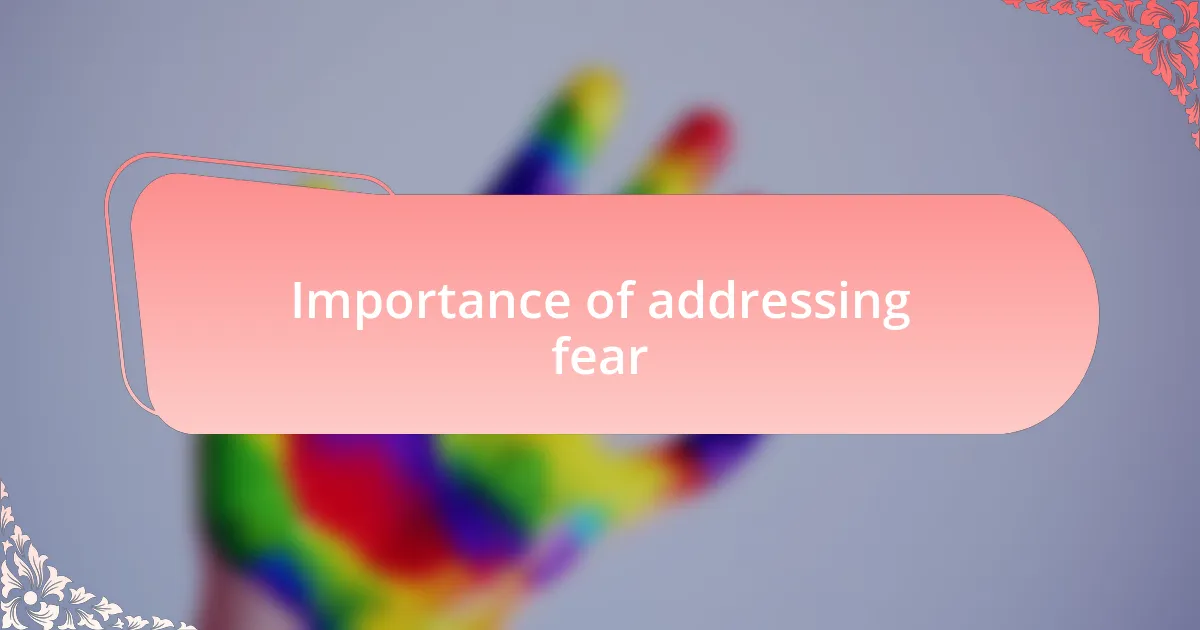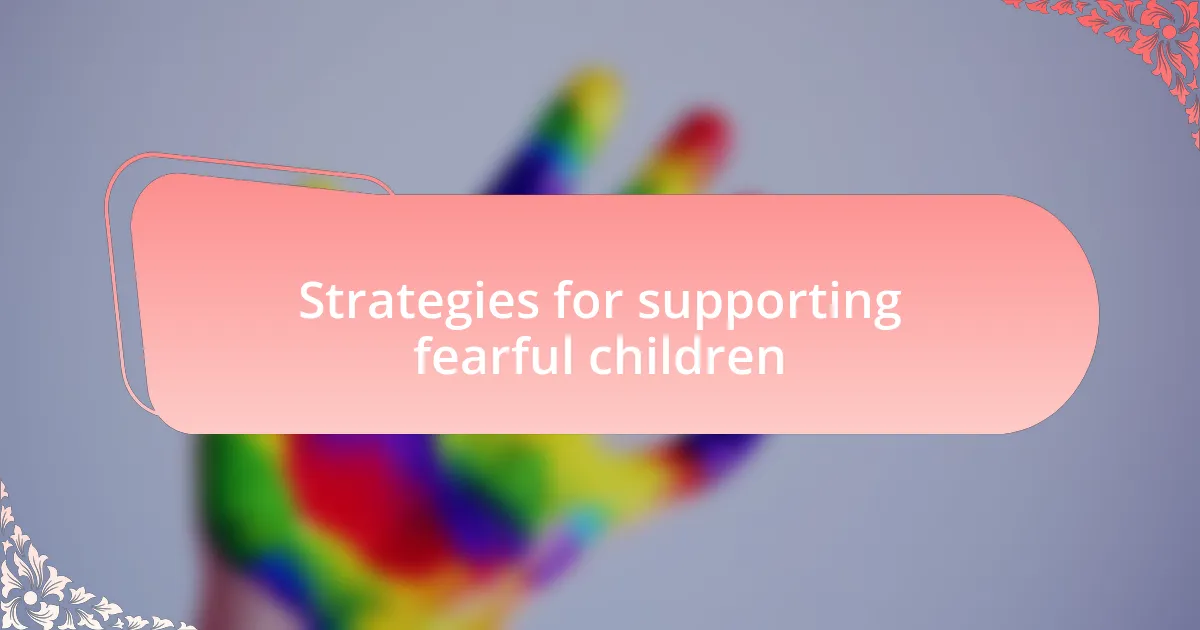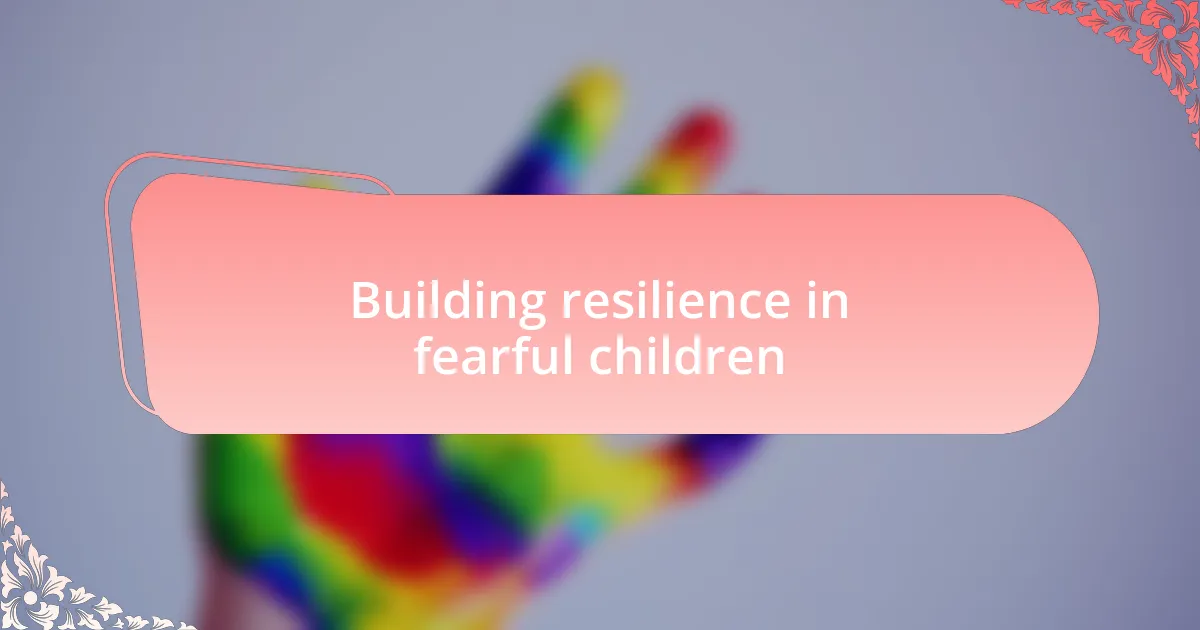Key takeaways:
- Children’s fear responses vary greatly; understanding individual reactions is crucial for emotional support and development.
- Addressing fears early fosters confidence, coping skills, and strengthens the parent-child bond.
- Practical techniques such as relaxation exercises, role-playing, and creating visual aids like a fear ladder can effectively ease children’s fears.
- Encouraging open communication about fears and celebrating small victories builds resilience in fearful children.

Understanding child fear responses
Children’s fear responses can be surprisingly complex. I remember my niece, who would freeze at the sight of a thunderstorm. It made me realize that what seems trivial to adults can feel monumental to a child, sparking their imagination in ways we often overlook. Have you ever seen a child dart behind a parent’s leg during a stranger’s approach? It’s a natural instinct for them, rooted in survival and the need to feel safe.
In my experience, these fear responses can vary greatly from one child to another. Some might react to loud noises with a scream, while others may withdraw into silence. This differentiation is crucial to understanding a child’s emotional landscape. Why do they choose one over the other? Those reactions can be influenced by personality, past experiences, and even the emotional climate at home.
It’s essential to acknowledge that fears can evolve over time. For instance, I once coached a child who was terrified of swimming. Initially, she was just anxious about the water; fear of what lurked beneath surfaced later on. This progression can be bewildering for parents. Understanding these shifts in fear responses doesn’t just help in providing support; it fosters a deeper connection, nurturing their emotional growth. So, how can we guide them through these fears? That’s where our empathy and patience become invaluable.

Importance of addressing fear
Addressing a child’s fears is paramount for their overall emotional and psychological well-being. I once observed a young boy who struggled with anxiety during school presentations. Watching him conquer his fear by practicing in front of family was heartwarming. It made me realize that by facing fears, children not only build confidence but also develop critical coping skills that serve them throughout their lives.
Ignoring or dismissing a child’s fears can lead to long-term consequences. I recall a friend whose daughter became increasingly anxious about social interactions. Instead of addressing these fears early on, they assumed she’d outgrow them. Unfortunately, that only led to deeper insecurities. Have you considered how allowing fears to fester might impact a child’s social development? The earlier we engage in open conversations about fear, the easier it becomes for children to navigate their emotions.
Moreover, tackling fears helps strengthen the parent-child bond. I had a moment with my nephew when we faced a spooky Halloween decoration together. By holding his hand and reassuring him, I witnessed an instant shift in his demeanor. This shared experience not only alleviated his fear but also deepened our trust. Isn’t it fascinating how confronting fears can foster connections that last a lifetime?

Strategies for supporting fearful children
One effective strategy for supporting fearful children is to create a safe space for them to express their feelings. I remember a day when my little cousin was terrified of thunderstorms. By sitting with her, listening to her worries, and validating her feelings, I noticed how much more comfortable she became. This simple act of acknowledgment helped her articulate her fears and led to a conversation where we explored ways to cope, like focusing on the comforting sounds of her favorite music during storms. Have you ever tried just listening without judgment? It can work wonders.
Another approach is to use gradual exposure to fears. I had a friend whose son was afraid of dogs. Instead of forcing him to interact with a large, barking dog right away, they started by observing dogs from a distance. Over time, they moved closer, and eventually, he found joy in petting a calm puppy. This method allows children to face their fears at their own pace, which can boost their confidence without overwhelming them. Doesn’t it make you think about the power of small steps?
Storytelling can also be a powerful tool. I vividly recall reading a book to my daughter about a brave little mouse who conquered her fear of the dark. As we flipped through the pages, I could see the excitement in her eyes and how the character’s journey resonated with her own feelings. Sharing stories not only provides a distraction but also illustrates that fear is a common experience. Have you explored using relatable narratives to connect with your child’s emotions? Engaging with stories can help them feel less isolated in their fears.

Practical techniques for easing fear
One practical technique for easing fear is to incorporate relaxation exercises into a child’s routine. I remember when my son was struggling with anxiety before bedtime. We started practicing deep breathing together, where we would take slow, deep breaths, counting to four. This not only calmed him down but also became a comforting ritual that improved his sleep and made him feel secure—have you thought about the impact of such simple practices on your child’s emotions?
Another effective method is to role-play scenarios that induce fear in a safe environment. I once worked with a child who was petrified of going to the dentist. By acting out a dental visit with toys, we were able to demystify the experience and even make it fun. We practiced what would happen and how to communicate with the dentist, turning a daunting situation into something more manageable. Have you ever played pretend with your child to address their worries? It truly opens up conversations and helps them see things from a new perspective.
Visual aids can also serve as a powerful tool for alleviating fears. I crafted a ‘fear ladder’ with my daughter, where we listed her fears from least to most scary. What amazed me was the way she took ownership of the process, feeling empowered to tackle her fears step-by-step. It encouraged her to discuss and reevaluate what frightened her most. Have you considered creating a visual aid like a fear ladder with your child? It can transform fear from an abstract emotion into something tangible they can work on.

Encouraging open communication
Open communication is essential when addressing a child’s fears. One evening, my daughter opened up about her fear of thunderstorms, something I underestimated until she mentioned how they made her feel small and helpless. Listening to her, I realized that validating her emotions without minimizing them made her more willing to share her thoughts. Have you taken the time to really listen to your child’s fears?
Creating a safe space for these conversations is crucial. I often set aside time during our weekend walks to talk, making it easier for her to express her worries. I found that the freedom of being outside removed some of the pressure—taking a casual stroll can transform a heavy topic into something more digestible. Have you explored different settings for such discussions with your child?
Encouragement is another vital element in fostering open communication. I remember a heartfelt moment when my son confided that he was afraid of being the last one picked in his soccer games. I praised his bravery for sharing that fear, reinforcing that vulnerability is a strength. This approach not only made him feel heard but also showed him that it was okay to be open about his feelings. How do you celebrate your child’s willingness to communicate their fears?

Building resilience in fearful children
Building resilience in fearful children requires a strategic approach that combines understanding, support, and gradual exposure to their fears. I recall a time when my daughter was afraid of meeting new friends at school. Rather than avoiding the situation, I encouraged her to attend a small playdate. Watching her take those tentative first steps was challenging, yet incredibly rewarding, as it became a foundation for her confidence in social settings. Have you considered how small, manageable challenges could empower your child to confront their fears?
Another critical aspect is teaching coping strategies. I vividly remember creating a “fear toolbox” with my son, filled with stress balls, calming music, and even a journal for his thoughts. It became a fun project for us, transforming fear into something manageable. Each time he faced a nerve-wracking situation, like speaking in front of his class, he would use techniques from his toolbox. Do you have strategies in place that can help your child navigate tough emotions?
Lastly, celebrating even the smallest victories can greatly enhance a child’s resilience. I remember being overjoyed when my little one shared that he felt less anxious about testing out for the school play. We celebrated together over his favorite ice cream, reinforcing the idea that overcoming fear, no matter how minor, is a significant achievement. How do you acknowledge and celebrate your child’s milestones, big or small?